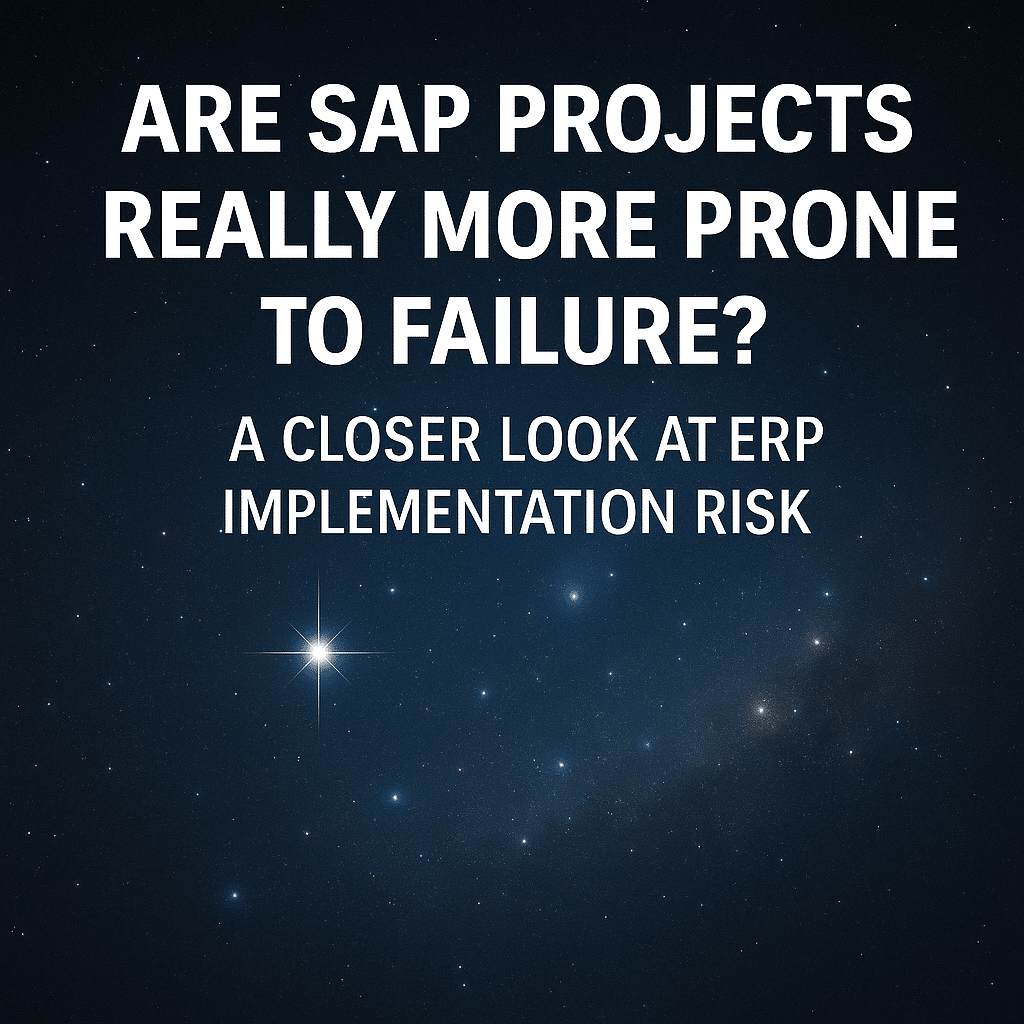Enterprise resource planning (ERP) failures have long been a source of frustration, finger-pointing, and costly lessons across industries. Over time, one software name seems to appear more frequently than others in discussions of failed ERP implementations: SAP.
From troubled supply chain rollouts to customer-facing disruptions, there is no shortage of stories highlighting SAP project struggles. But does that mean SAP is truly more failure-prone than other ERP systems, or is there a deeper explanation? Let’s explore why SAP tends to attract more negative headlines — and whether those perceptions reflect the full picture of ERP failure risk.
Table of Contents
ToggleWhy SAP Seems to Dominate Failure Headlines
There is no denying that SAP failures get a disproportionate amount of public attention. High-profile case studies, industry news stories, and even legal disputes often center on large SAP initiatives gone wrong. The reason for this visibility, however, is not necessarily tied to SAP as a product or as a company alone.
SAP is one of the largest and most widely adopted ERP platforms in the world, with a massive global customer base. Its clients tend to be some of the most complex, recognizable, and powerful enterprises — organizations that are consumer-facing, multinational, and highly integrated across industries. Think of global manufacturers, major consumer goods brands, and Fortune 500 players.
When these organizations experience an ERP failure, the consequences are highly visible. The media, investors, suppliers, and the general public notice because these brands are household names. In contrast, if a $100 million manufacturer with a regional presence fails an ERP rollout using a competing system, it rarely makes the news outside niche trade publications.
In that sense, SAP project failures are amplified because of the size, scale, and fame of its customers. Visibility does not necessarily equate to a higher failure rate, but it does skew public perception.
Complexity Raises the Stakes
Beyond brand recognition, another factor is the sheer complexity of SAP’s typical customer base. These organizations often operate in multiple countries, across different business units, with thousands of employees and countless unique processes.
This degree of operational complexity brings higher levels of risk to any large-scale digital transformation. Complex change programs face more potential pitfalls, more stakeholders, more resistance to change, and more competing priorities. These challenges can derail projects regardless of which ERP platform is in play.
In other words, it is not just SAP’s software that invites risk — it is the sophisticated, highly matrixed organizations deploying it. A small business implementing a simpler ERP system will almost always face fewer hurdles than a multinational trying to harmonize processes across dozens of global subsidiaries.
Are Other ERP Vendors Immune?
It would be a mistake to believe that SAP is the only ERP vendor associated with failure. In fact, every major ERP provider has been involved in troubled projects. Microsoft Dynamics 365, Oracle Fusion, Infor, Epicor, and Workday all have their share of implementation challenges.
Third-party consultants routinely help organizations recover from failed or stalled implementations across a wide range of ERP systems. Some of these projects fail due to unrealistic timelines, insufficient change management, poor data preparation, misaligned goals, or overly rigid customizations. These factors can derail a project regardless of the software brand.
In the market today, Dynamics 365 projects have revealed their own weaknesses and points of failure, particularly around change management and complex integrations. Oracle Fusion, while robust, is also not immune to challenges around customization, user adoption, or data migration. Similarly, Infor, Epicor, and Workday have all had high-profile or quietly catastrophic rollouts in the past decade.
No ERP vendor can promise failure-free results.
The Need for Objective Data
One of the challenges in answering whether SAP projects truly fail more often is the lack of objective, comprehensive industry data. Much of the discussion about ERP failures is anecdotal, drawn from press releases, lawsuits, and social media complaints.
At present, there is no reliable, centralized database that tracks and compares failure rates for every ERP vendor in a statistically valid way. Until the industry can consistently collect and analyze that data, these conversations will remain speculative.
Perception will continue to be shaped by news stories about big-name brands stumbling on high-budget SAP projects. That public narrative reinforces the impression that SAP is uniquely risky, even if other vendors face similar struggles behind the scenes.
Lessons for ERP Buyers and Executives
Whether you are considering SAP, Oracle, Microsoft, or another solution altogether, the lesson is clear: software alone does not determine project success or failure. ERP projects fail for a wide range of reasons — many of which have far more to do with organizational readiness than with the technical platform itself.
Here are critical steps every organization should keep in mind when preparing for an ERP transformation:
- Define a realistic scope and timeline. Many failures are born from overselling and underestimating the effort involved.
- Commit to rigorous change management. Technology is only a fraction of the transformation; getting people on board is essential.
- Invest in business process mapping and improvement. Poorly defined or outdated processes are a recipe for disaster.
- Select the right implementation partner. Not all system integrators are equal. Vet them carefully.
- Focus on data readiness. Clean, consistent, and well-governed data will make or break a successful go-live.
- Understand your customization boundaries. Over-customizing can introduce instability and complicate upgrades.
These disciplines apply no matter what ERP software you choose. The more complex your business, the more important it becomes to address these factors early and with intention.
A Call for Industry-Wide Discussion
The ERP market would benefit from more transparency about project outcomes, both successes and failures. Without consistent data, it is easy to focus on familiar brands as scapegoats while ignoring the bigger picture of why digital transformations struggle.
It is valuable to hear from organizations who have been through these projects themselves. What patterns have you observed in ERP failures? Have you found that certain vendors are more likely to encounter trouble, or do you see similar challenges across the industry?
Your insights — from business leaders, technology professionals, project managers, and consultants — can help demystify the reality of ERP risk. They can also serve as guidance for future ERP buyers who want to avoid repeating mistakes of the past.
Final Thoughts
SAP will likely continue to dominate failure headlines simply because of its scale, prominence, and the name recognition of its customers. But that does not make SAP uniquely flawed. Other ERP vendors experience failures for similar reasons, often hidden from public view because of smaller project footprints or less recognizable customers.
Ultimately, ERP failure is rarely about the software alone. It is about the intersection of technology, people, processes, and strategy — and how well those elements are aligned before, during, and after implementation.






